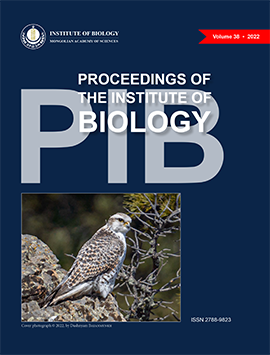Ornithological surveys at the Sainshand Wind Park
DOI:
https://doi.org/10.5564/pib.v38i1.2538Keywords:
wind farm, species composition, vantage point, migratory birdAbstract
Wind farm energy offers many advantages, which as economic efficiency, greenhouse gas reduction, air pollution reduction, and sustainable use of renewable energy resources but the impact of wind turbines on wildlife, especially birds, has been increasing in recent years. The main objective of the study is to determine the bird species composition and flight patterns in the vicinity of the Sainshand Wind Park (SWP) during the spring migration and breeding season. According to our research, a total of 126 species of birds belonging to 14 orders and 29 families were recorded in the wind park, with 70% of 88 species passing migratory birds. The peak of bird activity is between morning (08:00 – 11:00) and afternoon (17:00 – 19:00). In the risk zone of being hit by the turbine propeller (40 – 140 m) and it was found that birds including Black Kite and Upland Buzzard are the species at the highest risk of collision with the propeller blades. Therefore, in the future, it is necessary to carry out detailed research on breeding and feeding of birds of prey around the wind farm.
Сайншанд салхин паркийн шувууны судалгаа
Салхин паркийн тусламжтайгаар эрчим хүч үйлдвэрлэх нь эдийн засгийн үр ашигтай байдал, хүлэмжийн хийн хэмжээг бууруулах, агаарын бохирдлыг буураалах, сэргээгдэх эрчим хүчний нөөцийг тогтвортой ашиглахад чухал хэдий ч салхин сэнснээс зэрлэг амьтад тэр дундаа шувуудад үзүүлэх нөлөө сүүлийн жилүүдэд өсөн нэмэгдсээр байна. Энэхүү судалгааны зорилго нь Сайншанд Салхин Парк (ССП) орчмын шувууны зүйлийн бүрдэл, нисэлтийн хэв маягийг хаврын нүүдлийн үе болон үржлийн хугацаанд тогтоох юм. Бидний судалгаагаар нийт 14 баг 29 овгийн 126 зүйл шувуудыг хаврын нүүдлийн судалгааны үед бүртгэгдсэнээс шувуудын ихэнх буюу 88 зүйл (70%) дамжин өнгөрдөг нүүдлийн шувууд байна. Шувуудын идэвхжилийн хамгийн оргил үе нь өглөө (08:00 - 11:00) болон үдээс хойш (17:00 - 19:00) цагуудын хооронд байна. Сэнсний далбаанд цохигдох эрсдэлтэй бүс (40 - 140 м) бөгөөд Сохор элээ, Шилийн сар зэрэг шувууд энэ бүс нутагт сэнсний далбаанд цохиулах хамгийн өндөр эрсдэлтэй зүйлүүд болох нь тогтоогдсон. Иймд цаашид салхин парк орчмын махчин шувууны үржлийн болон хоол тэжээлийн судалгааг нарийвчлан хийх хэрэгтэй байна.
Түлхүүр үгс: Салхин парк, зүйлийн бүрдэл, харууц цэг, нүүдлийн шувуу
Downloads
315
References
R. Saidur, N. A. Rahim, M. R. Islam, and K. H. Solangi, “Environmental impact of wind energy,” Renew. Sustain. Energy Rev., vol. 15, no. 5, pp. 2423–2430, Jun. 2011, https://doi.org/10.1016/j.rser.2011.02.024.
T. D. Allison et al., “Impacts to wildlife of wind energy siting and operation in the United States,” Issues Ecol., vol. 21, no. 1, pp. 2–18, 2019.
A. L. Drewitt and R. H. Langston, “Collision effects of wind‐power generators and other obstacles on birds,” Ann. N. Y. Acad. Sci., vol. 1134, no. 1, pp. 233–266, 2008. https://doi.org/10.1196/annals.1439.015
W. Band, M. Madders, and D. P. Whitfield, “Developing field and analytical methods to assess avian collision risk at wind farms,” Birds Wind Farms Risk Assess. Mitig., pp. 259–275, 2007.
J. Munkh-Erdene, S. Gombobaatar, and D. Bayanmunkh, “Potential impacts on birds at Tsetsii wind farm, Mongolia.,” Ornis Mongolica, vol. 4, pp. 30–39, 2016.
S. Gombobaatar, D. Bayanmunkh, and B. Odkhuu, “Preliminary results of Ornithological surveys at the Salkhit uul wind park, Mongolia.,” Ornis Mongolica, vol. 3, pp. 3–8, 2014.
Montis LLC, “Bird Surveys during Pre-Construction of Sainshand Wind Park Project in 2014. Baseline Report. Prepared for Sainshand Wind Park LLC.,” 2015.
S. N. Heritage, “Recommended bird survey methods to inform impact assessment of onshore wind farms,” SNH Guid. Scott. Nat. Herit. Battleby, 2013.
G. Sundev and C. Leahy, “Birds of Mongolia helm field guides,” 2019.
M. Brazil, Birds of East Asia: China, Taiwan, Korea, Japan, and Russia. A&C Black, 2009.
L. Svensson, K. Mullarney, D. Zetterström, and P. Grant, “Bird guide: the most complete guide to the birds of Britain and Europe,” 2009.
B. Nyambayar, D. Batchuluun and D. Turbat, “A case of mass death of Pallas's Sandgrouse Syrrhaptes paradoxus in Uvurkhangai province due to a collision power lines” Toodog, vol. 2, pp. 34–40, 2016.
S. Gombobaatar, Saker Falcon (Falco cherrug) in Mongolia. Monograph. Ulaanbaatar. Mongolia p. 246. 2013. (in Mongolia)
Green Assessment LLC, “Bird survey report. Spring migration and Breeding season,” Sainshand Salkhin Park LLC, Ulaanbaatar. Mongolia, 2020.
C. García-Ripollés, P. López-López, and V. Urios, “Ranging behaviour of non-breeding Eurasian Griffon Vultures Gyps fulvus: a GPS-telemetry study,” Acta Ornithol., vol. 46, no. 2, pp. 127–134, 2011. https://doi.org/10.3161/000164511X625892
D. Bayanmunkh, “Impacts on birds from Salkhit Wind Park”. Master's thesis. National University of Mongolia. Ulaanbaatar. Mongolia, 2017. (in Mongolian)
Downloads
Published
How to Cite
License
Copyright (c) 2022 Damba Iderbat, Sukh-Ochir Mungunbagana

This work is licensed under a Creative Commons Attribution-NonCommercial 4.0 International License.
Copyright on any research article in the Proceedings of the Institute of Biology is retained by the author(s).
The authors grant the Proceedings of the Institute of Biology license to publish the article and identify itself as the original publisher.
![]()
Articles in the Proceedings of the Institute of Biology are Open Access articles published under a Creative Commons Attribution-NonCommercial 4.0 International License - CC BY NC.
This license permits use, distribution and reproduction in any medium, provided the original work is properly cited.




